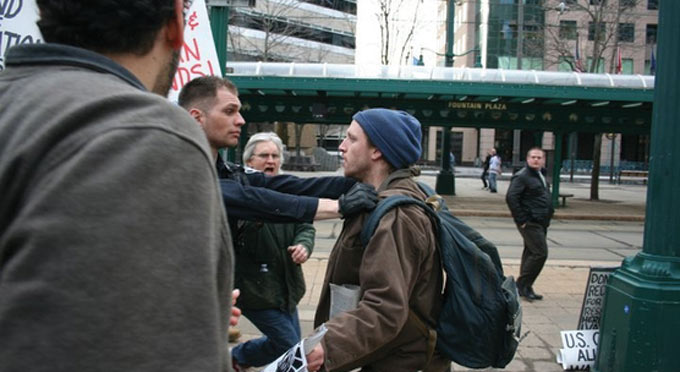The Acquittal of Nate Buckley
by George Sax

“We’re done here,” Buffalo City Court Judge Joseph A. Fiorella said from the bench shortly after 2:30pm on December 20, speaking to both prosecution and defense lawyers, as well as the defendant, Nate Buckley. He was bringing to an end an unusually long-running and well-publicized city court criminal case. Moments before, he had announced that he was dismissing all charges against Buckley, as he and his lawyers, Daire Brian Irwin and Michael Kuzma, had requested in August.
Buckley was arrested on April 8, 2011 in front of M&T Bank’s Fountain Plaza complex on Main Street in Buffalo as he and 40 to 50 others were engaged in a protest against war-promoting investments they accused the bank of making. Bank officials had responded by calling Niagara Frontier Transportation Authority police to the scene, three of whom arrested Buckley. He was eventually charged with a violation, trespass, and misdemeanor counts of obstructing governmental administration and resisting arrest, the last two each punishable by a maximum one-year imprisonment.
In a sternly worded 11-page decision that included expressions of disapproval of both the bank’s position, and particularly of the conduct of Buckley’s arrest, Fiorella agreed with the defense’s most important arguments in its motion to dismiss “in the interests of justice,” including its assertion that “this case should never have been brought.”
“The defense will argue,” Kuzma and Irwin wrote in their motion, that “the defendant’s intent was not to trespass, but rather to exercise rights guaranteed by the…United States Constitution, and…the New York State Constitution.”
They argued that City of Buffalo and Federal Government funding of the Fountain Plaza construction, and the bank’s long history of welcoming members of the public to the space undermined any claims of private-property rights to selectively exclude people peacefully expressing a political opinion. “In summary,” they wrote, “What we have here is trespass on public property with overzealous NFTA officers attempting to affect [sic] an arrest on individuals for legally exercising their constitutional rights.” The defense was prepared to argue at trial that Buckley had vacated the plaza when told to do so.
Fiorella’s decision accepted the bulk of the defense argument. Last spring, Buckley’s case went to trial and the jury had begun to deliberate when the judge had to call a halt to their work when a juror illegally sent a private message to Fiorella about another pending legal matter before him. Referring to that inconclusive trial, he wrote in his dismissal decision, “As defendant argues, and this court agrees, the People failed at trial to proffer proof beyond a reasonable doubt sufficient to convict.”
Leigh Anderson, Buckley’s lawyer during that trial, was forced to withdraw afterward, and Kuzma and Irwin were engaged and soon moved for dismissal.
Fiorella addressed the trespass charge, writing, “At trial, the bank’s deed was the only tangible document put into evidence to establish the People’s contention that the subject area was private property belonging to the bank.” Absent, he said, was any record of the bank’s notice to the public, a property survey, or any attempt to formally limit the public’s use of the plaza. Reminding the prosecution that earlier last year he had acquitted two other demonstrators of trespass charges at a bench trial, he said it would be “a travesty of justice” to convict Buckley on “the same proof.”
But Fiorella was most forcefully disapproving when he turned to Buckley’s arrest: “In addition, the Court is troubled by the actions of the NFTA.” Citing the bank’s own surveillance video, he said that Buckley had complied with an order to leave the disputed area, but, Fiorella went on, “Officer [Richard] Russo followed the defendant onto the public sidewalk, grabbed the defendant, and when he struggled, Officer Russo beat the defendant with his nightstick. Even though the defendant had been subdued against the wall, and had stopped struggling, Officer Russo pepper-sprayed the defendant in the face.”
Fiorella observed that “certain types of police actions manifest a disregard for cherished principles of law and order” and raised the question “whether the police themselves engaged in improper conduct repugnant to a sense of justice.” And he gave an answer: “This Court finds that Officer Russo did engage in improper conduct which is repugnant to this Court’s sense of justice.”
In an interview after the December 20 hearing, Buckley said the judge’s general description of what had occurred during his arrest was accurate, but that Fiorella had partly confused Richard Russo with Adam Brodsky, the officer Buckley said physically abused him. Russo, Buckley said, did follow and confront him, and his “resistance” chiefly amounted to protesting to Russo, “What are you doing? I got off the ledge [a wall at the edge of the plaza abutting the sidewalk].” Two years ago, Brodsky arrested a bicyclist at the NFTA’s downtown terminal and charged him with trespass, but City Court Judge James A. McLeod found that man innocent despite Brodsky’s testimony.
Irwin told Artvoice that, contrary to prosecutor Susan H. Sadinsky’s assertion, “Not only was Nate not a threat to society, he was doing something of great benefit to society.”
Kuzma said Fiorella’s dismissal “establishes good case law that may assist other people across the state seeking to exercise First Amendment rights.” He said it could interest other municipal judges in the state.
An effort to obtain a comment from Erie County District Attorney Frank A. Sedita Jr.’s office was unsuccessful.
blog comments powered by Disqus|
Issue Navigation> Issue Index > v12n1 (Week of Thursday, January 3) > Week in Review > The Acquittal of Nate Buckley This Week's Issue • Artvoice Daily • Artvoice TV • Events Calendar • Classifieds |









 Current Issue
Current Issue